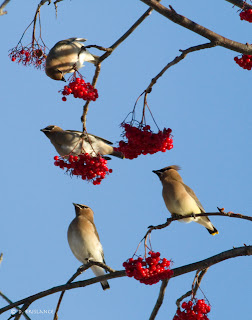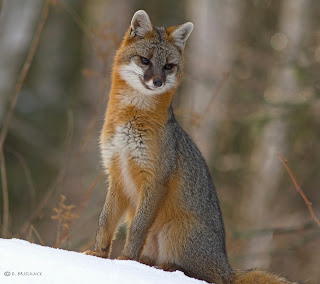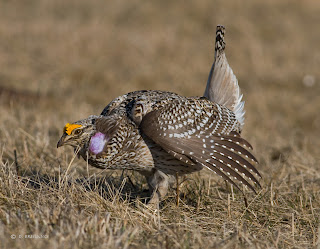I find I am not clever enough in my old age to design a title associating "black flies" with the Common Loon. So the title of this story has little to do with loon and tick content, but possibly a slight connection to the two canoeists and their many escapades.
During the spring and summer months, my friend Paul and I usually photograph many wildlife adventures together. In the month of May, we photographed the Sharp-tailed Grouse dancing on their lek in a hayfield south of Biwabik.
June found us in my "speed canoe", named by my youngest son. It is a Grumman sport boat that he cruised around in, with a 6 horse outboard motor which proved to be properly named. I decided to use it to photograph ducks and shore birds, so I attached an electric motor with adequate thrust to cruise the arrowhead lakes in silence.
Paul had photographed a nesting loon on one of the Gunflint lakes for a number of years, until a dead spruce fell on their nesting site. This obstruction caused the nesting pair to abdicate the site. We decided to take the speed canoe up to the lake and see if they found a different nesting site. It was a gorgeous June day, sunshine and no wind which was conducive to perfect photography weather. The only "fly in the ointment" were millions of the dreaded black flies hovering over the lake.
We spotted two loons far out in the lake. They were a considerable distance from the small island they previously nested on. We surmised that they were not the nesting pair from past years... but we were soon proved to be wrong. I cut the speed on the electric motor and we cruised toward the closest of the two islands. Much to our surprise, the two loons came toward us and followed parallel to the canoe. Heading slowly to the first island, the female loon swam under the canoe and led us to a spot on the shore of the island. She slid up the bank into a nest nearly in the water. We immediately thought we had found their nest and she was going to sit on her eggs. But it was strange they had been so far out on the lake away from their nest and eggs.
Paul took out his binoculars and found out why. He saw that there was an odd shaped egg in the nest and that she was trying to lift it up with her bill. The loon turned to face us and slide down the slight bank into the water. We saw that in her bill, she had part of a damaged egg and was carrying it out into deeper water.
 |
| Burying Egg |
She swam right past the canoe and dove with the egg and buried it in the deep water. I have seen many different wildlife scenarios in my photographic life, but nothing as bizarre as this. First of all, why did the loons not clean out the predator damaged eggs before our arrival? Secondly, why did she want us to observe her disposing and burying the egg? This was quite dumbfounding to us, but to witness this event was certainly one in a million.
We took many photos of the two loons, all depicting the black fly horror that the wildlife has to endure this time of the year in the wilderness. When they dove and surfaced, they were immediately covered with black flies. In some areas, they are driven off their nest by these flies and their nests are abandoned.
 |
| Loon and Black Flies |
 |
| Loon and Black Flies |
Humans can dress properly, but the wildlife can do little until the vicious #$*%&^# disappear in the fall freeze.
 |
| Bug Shirt |
Paul and I found the loons previous nesting site and cleared out the debris of the dead spruce that covered their old site. We wanted to get back to the lake later to see if they re-nested and laid new eggs, but other summer adventures prevented a return.
Hopefully they will return next spring and use their old nesting spot that was in a much better location.
"One of the wildest and most striking of all the wilderness sounds, a strange, sad, mournful, unearthly cry, half laughing, half wailing." John Muir on the Loon.
"One of the wildest and most striking of all the wilderness sounds, a strange, sad, mournful, unearthly cry, half laughing, half wailing." John Muir on the Loon.































































































